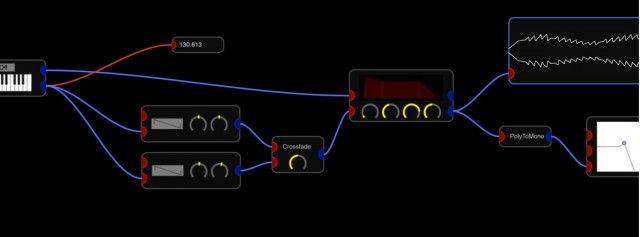


Since the middle two notes are quite close to the purely tuned fourth and fifth I could also choose to embrace them. If I wanted to create a pentatonic scale with 5 equally spaced steps, the closest that I can get with this set of ratios is something like this: 1/1 8/7 21/16 32/21 7/8 2/1.

Or in a different transposition: 1/1 10/9 5/4 3/2 5/3 – the ‘major pentatonic´. The main difference between the two scales is that the Pythagorean version has same size major second throughout: the so-called major whole tone, which corresponds to the ratio of 9/8, whereas the ‘pure’ version starts off with a minor whole tone, corresponding to the ratio of 10/9, followed by a major whole-tone, followed by a pure minor third 6/5, and then a minor whole-tone at the top. But the ‘pure’ version has a slightly different character. So the Pythagorean version comes quite close to an equally tempered tuning. Let me add an arpeggiator and we can compare. And that got me thinking of Clarence Barlow’s notion of harmonicity and wondering what the scale might sound like when tuned with the simplest ratios possible: 1/1 6/5 4/3 3/2 9/5. So what we have here is Ben Johnston’s Pythagorean tuning of the minor pentatonic, and you can see that it starts with quite a complex ratio: 32/27 for the minor third.
#Midi keyboard audulus 3 series
We can set up the scale by stacking up a series of fifths: 4/3 2/1 3/2 9/8 27/16. Now that I have all these ratios at my fingertips, having set up my Partch overlay for the Sensel Morph, I thought it might be interesting to take a look at the humble pentatonic scale and the various ways in which it might be tuned. 81/80:32/31, things can get a little more complicated and so I’ve set up a spreadsheet to do the work for me, also including a representation of the interval in terms of cents using the following formula: 1200*log(n/d)/log(2) where n/d is your ratio.Īnd to make things a little more fun I’ve set up a small device using the Audulus 4 beta that uses the same principles to display both the ratio and the cents of any two notes played on the keyboard in real time. With some of the more complex ratios, e.g. So in the case of 4/3 and 3/2 we would have 3×3=9 and 4×2=8, which gives us the ratio of 9/8, which we know is the major whole tone that we have between a perfectly tuned fourth and fifth. In his book Genesis of a Music Partch himself points out that it’s easy to calculate the ratio between two ratios by simply inverting the smaller of the two and using that to multiply the other. One thing is having all the ratios of the Partch 43-tone scale nicely presented with this keyboard layout but how does one get a handle on the ratios between the ratios?


 0 kommentar(er)
0 kommentar(er)
